
The Calliphoridae are a family of insects in the order Diptera, with almost 1,900 known species. The maggot larvae, often used as fishing bait, are known as gentles. The family is known to be polyphyletic, but much remains disputed regarding proper treatment of the constituent taxa, some of which are occasionally accorded family status.

Oestroidea is a superfamily of Calyptratae including the blow flies, bot flies, flesh flies, and their relatives. It occurs worldwide and has about 15,000 described species.
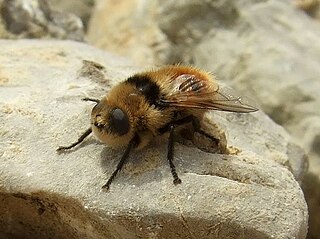
Botflies, also known as warble flies, heel flies, and gadflies, are a family of flies known as the Oestridae. Their larvae are internal parasites of mammals, some species growing in the host's flesh and others within the gut. Dermatobia hominis is the only species of botfly known to parasitize humans routinely, though other species of flies cause myiasis in humans.

The Gasterophilinae are a subfamily of Oestridae which includes large, parasitic flies; this group has historically been treated as a family, but all recent classifications place them firmly within the Oestridae. Many members of this subfamily spend part of their larval stages in the digestive tracts of herbivores. The best known genus is Gasterophilus, which attacks horses, deer, and similar animals. The genus Cobboldia breeds in elephants. The genus Gyrostigma breeds in rhinoceroses.

Horse-flies and deer flies are true flies in the family Tabanidae in the insect order Diptera. The adults are often large and agile in flight. Only female horseflies bite land vertebrates, including humans, to obtain blood. They prefer to fly in sunlight, avoiding dark and shady areas, and are inactive at night. They are found all over the world except for some islands and the polar regions. Both horse-flies and botflies (Oestridae) are sometimes referred to as gadflies.

The Cuterebrinae, the robust bot flies, are a subfamily of Oestridae which includes large, parasitic flies; this group has historically been treated as a family, but all recent classifications place them firmly within the Oestridae. Both genera spend their larval stages in the skin of mammals. The genus Cuterebra, or rodent bots, attack rodents and similar animals. The other genus, Dermatobia, attacks primates, including humans.

Oestrinae is a subfamily of Oestridae which includes parasitic flies attacking a range of different hosts. There are 9 genera with 34 species in this subfamily, which typically spend their larval stage in the skin or soft tissues of mammals, including deer or sheep. The adult flies give birth to living larva in the host's nostril.

The Chamaemyiidae are a small family of acalyptrate flies with less than 200 species described worldwide. The larvae of these small flies are active and predatory and are often used for biological control of aphids, scale insects, and similar pests. Chamaemyiid fossils are poorly represented in amber deposits, but a few examples are known from the Eocene epoch onwards.

Canacidae, incorrectly Canaceidae, or beach flies, surf or surge flies, is a family of Diptera. As of 2010, 307 species in 27 genera. The family now includes Tethininae as a subfamily.
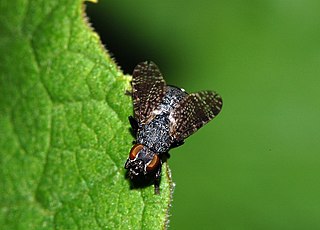
The Platystomatidae are a distinctive family of flies (Diptera) in the superfamily Tephritoidea.
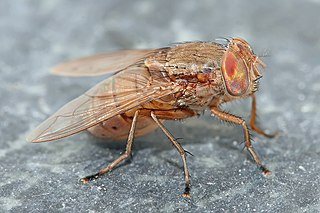
Bengalia is a genus of blow flies in the family Calliphoridae with one authority considering the genus to belong to a separate family Bengaliidae. These bristly and, unlike the greens and blues of most calliphorids, dull coloured flies, are especially noted for their relationship to ants. Little is known of their biology and life-cycle, although adults of many species are kleptoparasitic on ants and will snatch food and pupae being carried by ants or feed on winged termites. The apt name “Highwayman Fly” was given by an early observer of their way of robbing ants. Very little is known about their breeding habits. The genus is found in the Afrotropical and oriental region with one species from Australia possibly a recent introduction.

Asilinae is a large subfamily of flies in the family Asilidae, the robber flies and assassin flies. It includes over 180 genera.

Chrysogaster is a genus of small hoverflies in the subfamily Eristalinae. They are dark or black with shiny colourful reflections and can often be seen visiting flowers in damp marshy areas where the aquatic larvae live. Species in the related genera Melanogaster, Orthonevra, Lejogaster and Riponnensia were formerly treated as members of Chrysogaster.

Cerioidini is a widespread tribe of around 222 species of hoverfly. Cerioidini are mistaken for wasps for which they are effective mimic. Cerioidini have antennae with a terminal style and have somewhat elongate and basally constricted abdomens, only slightly in Ceriana, but pronounced in most Sphiximorpha; and Polybiomyia, and extremely in Monoceromyia. Larvae live mostly within tree sap associated with tree wounds or putrefying pockets of water in tree cavities.
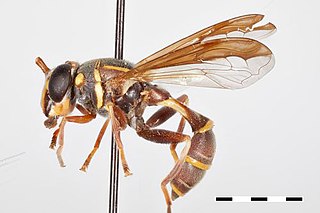
Polybiomyia is a genus of hoverfly.

Andy Z. Lehrer was a Romanian entomologist. From 1996 until his death, he worked as a research associate in the laboratory of Zoology at the University of Tel Aviv in Tel Aviv, Israel. For several years, he studied flesh flies and blow flies from all over the world.

Chrysopsinae is an insect subfamily in the family Tabanidae commonly known as deer flies or sheep flies and are bloodsucking insects considered pests to humans and cattle. They are large flies with large brightly-coloured compound eyes, and large clear wings with dark bands. They are larger than the common housefly and smaller than the horse-fly.

Plastotephritinae is a subfamily of flies (Diptera) in the family Platystomatidae, which currently includes 18 genera.
Trapherinae is a subfamily of flies (Diptera) in the family Platystomatidae, which currently includes 11 genera.
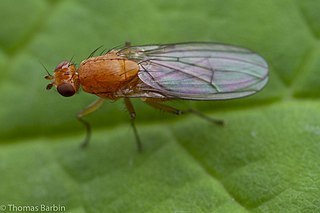
Suilliinae is a subfamily of flies in the family Heleomyzidae. The two genera in this subfamily were formerly placed the subfamily Heleomyzinae, but they are now considered to make up a subfamily of their own.



















